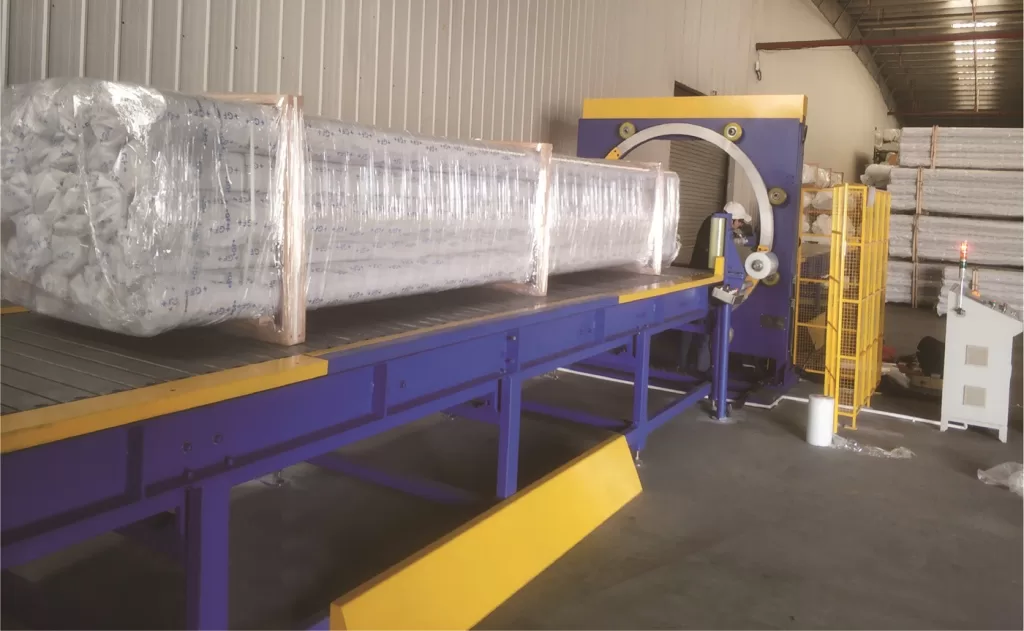Optimizing Sandwich Panel Packaging: Integrating Automated Wrapping Lines
Sandwich panels, essential components in modern construction for walls, roofs, and cold storage, require careful handling and packaging to prevent damage during transport and storage. Manual packaging processes can be labor-intensive, inconsistent, and pose safety risks. Implementing an automated sandwich panel wrapping machine and packaging line offers a robust solution to these challenges, enhancing both efficiency and product protection.
The Need for Specialized Panel Packaging
Standard packaging methods often fall short for sandwich panels due to their size, weight, and susceptibility to surface scratches, edge damage, and moisture ingress. Effective packaging must:
- Protect sensitive surfaces and insulation cores.
- Secure panels firmly to prevent shifting during transit.
- Provide weather resistance for outdoor storage or transport.
- Facilitate easier and safer mechanical handling (e.g., forklift access).
Automated wrapping systems are specifically designed to address these requirements consistently and efficiently.
Understanding Sandwich Panel Wrapping Systems
Modern packaging lines typically integrate several components to streamline the process from production output to final dispatch. Key elements often include:
Wrapping Technology
- Orbital Wrapping Machines (Spiral Wrappers): These are commonly used for panels. A ring carrying a roll of stretch film travels around the stationary or slowly moving panel, applying the film spirally along its length. This method provides complete coverage and excellent load containment. The video above demonstrates an orbital wrapping process for sandwich panels. Different machine sizes and configurations, such as specialized horizontal orbital wrapping machines, are available to accommodate various panel dimensions and throughput needs.
Core Components of a Packaging Line
- Infeed/Outfeed Conveyors: Automated transport systems (roller or belt conveyors) move panels smoothly into and out of the wrapping station.
- Wrapping Station: Houses the orbital ring or wrapping mechanism.
- Film Delivery System: Controls the application of stretch film, often featuring pre-stretch capabilities to maximize film yield and secure wrapping tension.
- Clamping, Cutting, and Sealing Unit: Automates the start and end of the wrapping cycle.
- Optional Modules: Depending on requirements, lines can include automated corner protection applicators, top sheet dispensers (for added weather/dust protection), and stacking/bundling units. Comprehensive integrated automatic panel packaging lines handle the entire process seamlessly.
Operational Benefits for Fabricators
Integrating an automated wrapping line yields significant advantages:
Enhanced Product Protection
- Consistent Coverage: Ensures panels are uniformly wrapped, minimizing exposure to potential damage sources like scratches, impacts, moisture, and UV radiation.
- Load Stability: Tightly wrapped panels or bundles are more stable, reducing the risk of damage during handling and shipping.
Improved Handling and Logistics
- Unitization: Bundles multiple panels into a single, manageable unit, simplifying loading, unloading, and inventory management.
- Handling Safety: Reduces manual handling requirements, decreasing the risk of worker strain or injury.
Increased Throughput and Efficiency
- Automation Speed: Significantly faster than manual wrapping, allowing packaging operations to keep pace with production output.
- Reduced Bottlenecks: Streamlines the end-of-line process, preventing delays.
Cost Optimization
- Labor Savings: Frees up personnel previously assigned to manual wrapping for other value-added tasks.
- Material Efficiency: Pre-stretch systems optimize stretch film usage, potentially reducing consumable costs.
- Reduced Damage Claims: Better protection leads to fewer instances of product damage and associated replacement or repair costs.

1horizontal wrapping machine gg1500 ce approved convey Key Considerations for Implementation
Selecting and integrating the right sandwich panel packaging line requires careful planning:
- Panel Specifications: Define the range of panel dimensions (length, width, thickness), weights, and surface types the system must handle.
- Throughput Requirements: Determine the necessary packaging speed (panels per hour or shift) to match production capacity.
- Packaging Needs: Specify the required level of protection – e.g., film layers, need for corner protectors, top sheets.
- Film Type: Consider the appropriate stretch film specifications (thickness, puncture resistance, UV inhibitors).
- Line Integration: Ensure seamless connection with upstream (production) and downstream (storage/loading) processes. Compatibility with existing conveyor systems is crucial.
- Available Footprint: Assess the physical space available for the equipment layout.
- Supplier Reliability: Evaluate potential suppliers based on machine quality, technical support, service availability, and spare parts accessibility.
Conclusion
For fabricators of sandwich panels, investing in an automated wrapping machine and packaging line is a strategic move towards improved quality control, operational efficiency, and workplace safety. By carefully selecting a system tailored to specific production needs, manufacturers can ensure their products arrive at the customer's site in optimal condition, reinforcing brand reputation and reducing costly damage claims. These systems represent a vital component in streamlining modern panel manufacturing and logistics.